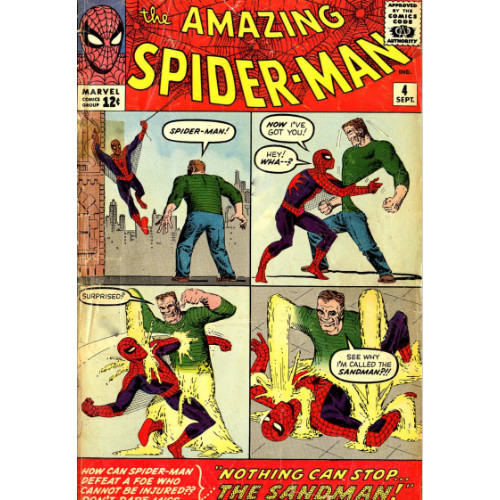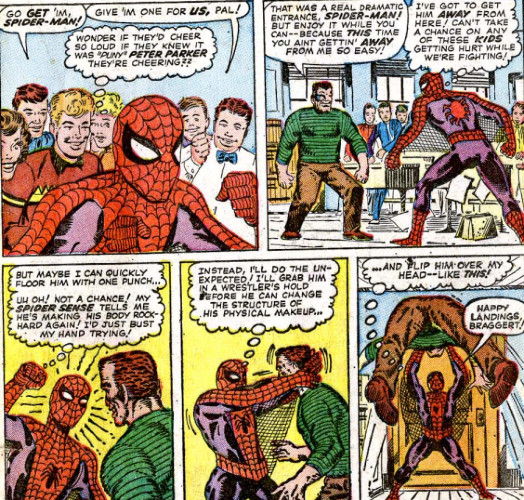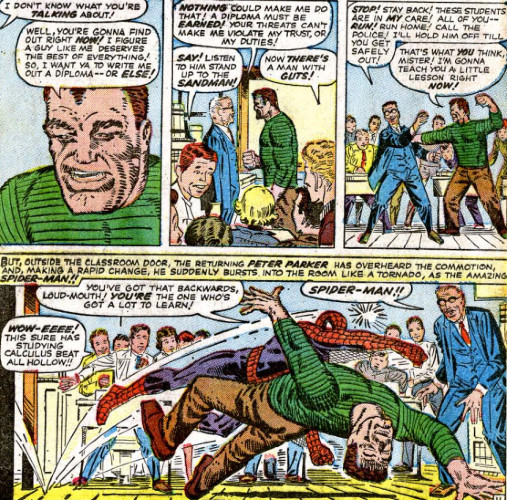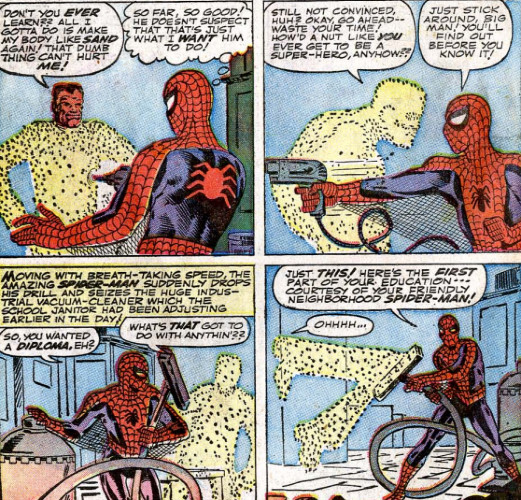Crawling Back: Amazing Spider-Man #4 Review (The Sinister Six, Part 3)
Steve Ditko's creativity carries an issue introducing a villain whose potential outstrips his first appearance
—by Nathan on January 24, 2024—

I've said it before, and I'll say it again: I love classic Spider-Man villains.
The Stan Lee/Steve Ditko era produced many of the "love to hate" adversaries Spidey's fought over the decades across multiple mediums. Two of the pair's co-creations, Doctor Octopus and the Green Goblin, have long battled over that coveted "greatest Spidey villain" title, and though it has switched hands over the last several years, the Goblin rose to the top by time Ditko left the title. But Lee and Ditko are responsible for a wealth of other supervillains–Kraven the Hunter, the Chameleon, the Vulture, Mysterio, Electro, and the focus of today's post, the slippery Sandman.
I've spent several "Crawling Back" posts recently covering the developing mystery of the Green Goblin and wanted to take a step back from that, both metaphorically and chronologically. After reviewing Erik Larsen's revival of the Sinister Six, I wanted to spotlight the first appearances of each of the team's original members.
The Vulture first raised his talons against Spidey in our humble hero's third appearance (and the second issue of his first ongoing series, Amazing Spider-Man), and the devious Doc Ock handed (and handed…and handed…) Spidey his first defeat the following issue. Now, four issues in, Amazing Spider-Man debuts yet another original adversary in the guise of Flint Marko, the Sandman. No, not the Neil Gaiman character, the DC Comics hero, or the mystical man who helps you fall asleep. This Sandman does want Spidey to take a nap, though…a dirt nap.
"Nothing Can Stop…The Sandman"
Writer: Stan Lee
Penciler: Steve Ditko
Inker: Steve Ditko
Colorist: Stan Goldberg
Letterer: Artie Simek
Issue: Amazing Spider-Man #4
Issue Publication Date: September 1963

When I read through these early stories, I try to look beyond the way in which the narratives were written to examine the underlying plots, characterization, and themes. It's telling that updated versions of some of Lee and Ditko's earliest stories that I've read are often more entertaining on the surface–the art is a bit more modern, the dialogue less effusive. The same general themes and ideas which drive Lee and Ditko's stories are largely intact; the reading experience, however, is easier. I sometimes wrestle with these older tales–as much as I enjoy the themes of power and responsibility I can glean from Spidey's origin, or as engaging as the notion of Spidey's swelled head getting pinpricked by his first defeat at Doc Ock's long limbs is, the experience of reading those issues to get to the theming feels like a bit of a slog. Kinda like wading through quicksand. The actual words sometimes fail to convey the deeper, creative notions Lee wants us to grasp.
Lee and Ditko are fueled by that pure creativity here–if you're not already enthralled by a superhero with a far more unique method of transportation than flying or running, or if you're not quite persuaded by the mad scientist with the multiple arms, why not have your mind blown by the guy who can turn himself into sand? Yeah, sometimes he just stretches himself–Spidey makes the obvious Mr. Fantastic comparison here–but Flint Marko's alter ego is so much more than a human rubber band. Ditko seems to have a blast toying with the visuals, whether it's Spidey punching through a sandy chest, Marko snaking his way out of the arms of the law, or the villain jumping from a building, turning into his granular form, and putting himself back together as he reaches the ground. The whole issue is a visual feast, Lee's ecstatic showmanship be darned. Ditko's imagination is given breath through multiple action sequences, as if the artist is trying to wriggle out from under his co-creator's wordiness. Let the art do the talking this time, Stan.

Flint Marko really becomes the star of the issue. Small bits are dedicated to slowly developing subplots–the enmity growing between Spidey and J. Jonah Jameson, the rivalry between Flash and Peter, even hints at romantic tension between Peter and Liz Allen (who, for my money, never ranked as high on the "girls that Peter actually didn't end up with permanently" list as Betty, Gwen, or even Felicia Hardy)–but the Sandman pervades the issue. He beats Spidey in their first encounter, evades the cops, and nearly trounces the Web-Head during their second fight. Much of his appeal is that visual aspect; narratively, he's a bit of a dunce, his motivations plain. He robs banks, runs from the cops, seeks asylum in a high school. Lee brings about some odd plotting when the villain demands the high school principal basically hand him a diploma–it showcases Sandy's somewhat slow thought process, as well as a slightly more sinister side when he starts threatening people. But the scene feels off; there's no real narrative reason why Sandy should want a diploma other than for Lee and Ditko to show he's a brute.
Like other characters, the deeper appeal of the Sandman in this issue comes courtesy of his later history. We see here a prototype of the Sandman, a guy who'd go on to join the Sinister Six (more than once), spent a decent chunk of time trying to reform himself (metaphorically and physically), and develop some fairly iconic story arcs. I think back to "The Gauntlet," a favorite arc of mine, where Fred van Lente let the Sandman wrestle with his personality, showcasing some surprising duality. Who the Sandman becomes eclipses who he is in this issue, much like the Vulture or even a bit like Doc Ock. But this is the beginning of a celebrated saga in the life of Spidey's rogues gallery, a Sandman who is born, awoken, instead of causing sleep.

Sandman just so happens to pop up at this issue's "low point," right after Spidey ensnares some crooks before they commit a crime who then accuse Spidey of assault and battery. His initial loss to Sandman just perpetuates a sense of defeat throughout the issue, meaning Spidey's later victory over the seashore-shaped supervillain feels that much more worthy of applause. The struggle is very similar to the prior issue, where Spidey was soundly defeated by the insidious Doctor Octopus before claiming a late triumph over his foe (with a much needed yet unintentional pep talk from the Human Torch). Fortunately, for this issue, Lee's dialogue is less pretentious; in ASM #3, Spidey practically begged the universe to throw him a tough guy to fight, and Octopus stomped him in their first encounter. Despite sometimes feeling like he's trying to crowd out Ditko, Lee allows a great atmosphere of tension to permeate this issue–nowhere does Spidey lament his troubles, only for the Sandman to conveniently exacerbate them. The tension is left for the reader to absorb, to apply that confounding "Parker Luck" that’s haunted our hapless hero from the very beginning.
Yet it makes victory all the sweeter. Much like prior issues, Spidey's intelligence is what enables him to save the day, though one could argue it's not quite the same feat as beating Doc Ock in a battle of wits. As mentioned, the Sandman basically demands he be given a high school diploma in this issue, so it's Spidey fighting a guy who thinks schools peddle degrees like back alley pharmaceuticals. To our creators' credit, Lee and Ditko even have the foresight to hint at the means behind Sandman's dusty defeat–it's just a panel, seemingly with no context attached to the primary story, yet Spidey cleverly makes this scant reference the crux of his triumph over the Sandman. Sandy's defeat is engaging enough, but it's the care placed into foreshadowing how Spidey outwits this human sandbox which makes the ending all the more rewarding.

Aside from the issue's clever criminal and the series' penchant for showing Spidey as a "brains over brawn" kinda fella who doesn't always have to pulverize his villains to secure a win, this issue is pretty traditional if we're going by modern standards. Today's Spidey fans have grown accustomed to our hero grousing over and playing pranks on J. Jonah Jameson, outwitting enemies (particularly those more powerful than he is), falling into unfortunate circumstances where the public vilifies him when he was just trying to help. We're used to watching poor Peter Parker flub an opportunity with a young woman, come into conflict with that loudmouthed Flash Thompson (even if they developed a friendship later on), and bemoan the responsibilities attached to his amazing powers like a leech or an alien parasite slowly consuming your life. It's sometimes not so fun being Spider-Man…which makes it all the stranger when our enjoyment of Spidey's adventures is proportional to Peter Parker's displeasure. I guess that's part of the reading experience: hoping this young man with the weight of the world on his shoulders will one day realize he doesn't need to slog through his bitterness like an agonizing wade through a pit of quicksand.